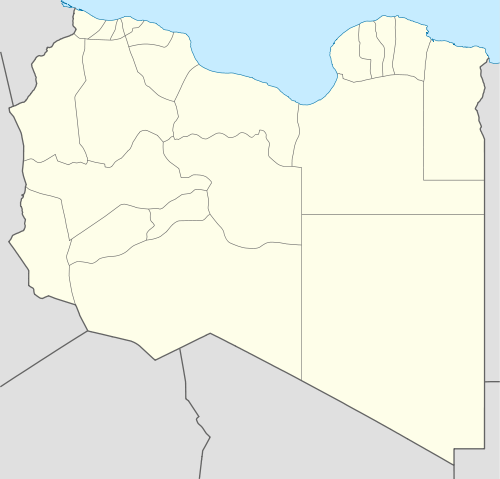Traghan
| Traghan تراغن Taraghen | |
|---|---|
| Town | |
 Traghan Location in libya | |
| Coordinates: 25°55′24″N 14°25′14″E / 25.92333°N 14.42056°ECoordinates: 25°55′24″N 14°25′14″E / 25.92333°N 14.42056°E | |
| Country |
|
| Region | Fezzan |
| District | Murzuq |
| Time zone | EET (UTC+2) |
Traghan or Traghen[1] is a small town in the Murzuk Desert in Murzuq District in southwest Libya. It is located east of Murzuk and Zizau. A good high road is said to link Traghan to Zizau in the west, with frequent incrustations of salt.[1]
History
Traghan by the 13th century was dominated by the Saifawa dynasty, a remarkable feat as Traghan lies 1380 kilometres from Njimi, the Saifawa capital.[2]The Saifawa were said to have "gained control of the Fezzan by establishing a post in the oasis of Traghan about twenty miles east of modern Murzuk and some seventy miles west-south-west of ancient Zawila." [3]
Traghan was approached by western explorers on 29 November 1822.[4] In the late 1820s, Traghan was described as was formerly as considerable a place as Murzuk; and was, about sixty years ago, the residence of a sultan, who governed eastern Fezzan. It was described as being in a flat, desert plain, with gardens and date groves.[5] It contained four mosques with small mud minarets and the houses were mostly large but in ruin.[5]The population in the late 1820s was estimated to be 500-600 but it had previously been far more populous.[5]Major Denham noted that the people of Traghan were exceptionally skilled in carpet making and their carpets rivaled those of Constantinople.[5] Hugh Murray later noted its fine carpets in the early 1850s.[6]
References
- 1 2 Hornemann, Friedrich; Laing, Alexander Gordon (1964). Missions to the Niger. Published for the Hakluyt Society at the University Press. Retrieved 18 September 2011.
- ↑ Shillington, Kevin (2005). Encyclopedia of African history: A-G. CRC Press. p. 273. ISBN 978-1-57958-245-6. Retrieved 18 September 2011.
- ↑ Smith, Abdullahi (1987). A little new light: selected historical writings of Professor Abdullahi Smith. Abdullahi Smith Centre for Historical Research. p. 91. ISBN 978-978-2557-96-4. Retrieved 18 September 2011.
- ↑ Jameson, Robert; Wilson, James; Murray, Hugh (1830). Narrative of discovery and adventure in Africa: from the earliest ages to the present time: with illustrations of the geology, mineralogy and zoology. Oliver & Boyd. p. 344. Retrieved 18 September 2011.
- 1 2 3 4 Conder, Josiah (1830). Africa. J. Duncan. p. 175. Retrieved 18 September 2011.
- ↑ Murray, Hugh (1853). The African continent : a narrative of discovery and adventure. T. Nelson. p. 155. Retrieved 18 September 2011.